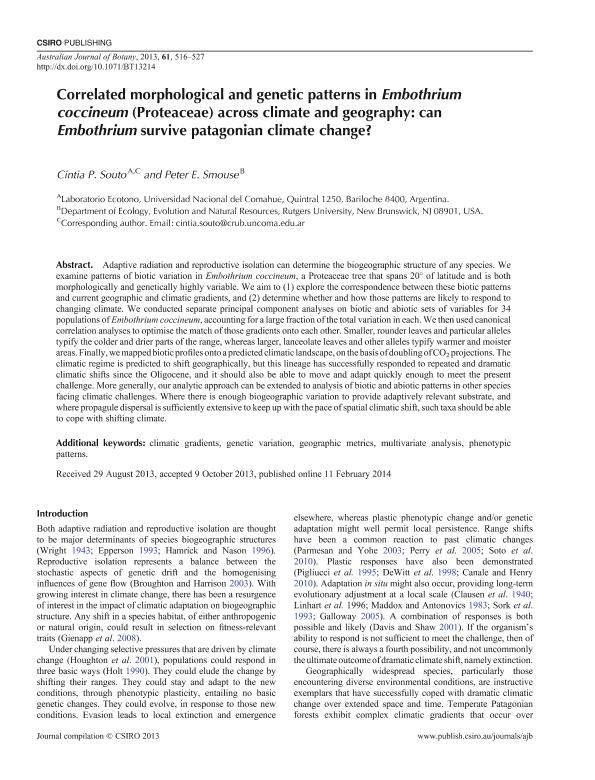Mostrar el registro sencillo del ítem
dc.contributor.author
Souto, Cintia Paola

dc.contributor.author
Smouse, Peter E.
dc.date.available
2016-07-27T20:51:03Z
dc.date.issued
2013-12
dc.identifier.citation
Souto, Cintia Paola; Smouse, Peter E.; Correlated Morphological and Genetic Patterns in Embothrium coccineum (Proteaceae) Across Climate and Geography: Can Embothrium Survive Patagonian Climate Change?; Csiro Publishing; Australian Journal of Botany; 61; 7; 12-2013; 516-527
dc.identifier.issn
0067-1924
dc.identifier.uri
http://hdl.handle.net/11336/6743
dc.description.abstract
Adaptive radiation and reproductive isolation can determine the biogeographic structure of any species. We examine patterns of biotic variation in Embothrium coccineum, a Proteaceae tree that spans 20º of latitude and is both morphologically and genetically highly variable. We aim to: (1) explore the correspondence between these biotic patterns and current geographic and climatic gradients, and (2) determine whether and how those patterns are likely to respond to changing climate. We conducted separate Principal Components Analysis on biotic and abiotic sets of variables for 34 populations of Embothrium coccineum, accounting for a large fraction of the total variation in each. We then used canonical correlation analyses to optimize the match of those gradients onto each other. Smaller, rounder leaves and particular alleles typify the colder-drier parts of the range, while larger, lanceolate leaves and other alleles typify warmer-moister areas. Finally we mapped biotic profiles onto a predicted climatic landscape, based on doubling of CO2 projections. The climatic regime is predicted to shift geographically, but this lineage has successfully responded to repeated and dramatic climatic shifts since the Oligocene, and it should also be able to move and adapt quickly enough to meet the present challenge. More generally, our analytic approach can be extended to analysis of biotic and abiotic patterns in other species facing climatic challenges. Where there is enough biogeographic variation to provide adaptively relevant substrate, and where propagule dispersal is sufficiently extensive to keep up with the pace of spatial climatic shift, such taxa should be able to cope with shifting climate.
dc.format
application/pdf
dc.language.iso
eng
dc.publisher
Csiro Publishing

dc.rights
info:eu-repo/semantics/openAccess
dc.rights.uri
https://creativecommons.org/licenses/by-nc-sa/2.5/ar/
dc.subject
Climatic Gradients
dc.subject
Climate Change
dc.subject
Genetic Variation
dc.subject
Geographic Metrics
dc.subject.classification
Genética y Herencia

dc.subject.classification
Ciencias Biológicas

dc.subject.classification
CIENCIAS NATURALES Y EXACTAS

dc.title
Correlated Morphological and Genetic Patterns in Embothrium coccineum (Proteaceae) Across Climate and Geography: Can Embothrium Survive Patagonian Climate Change?
dc.type
info:eu-repo/semantics/article
dc.type
info:ar-repo/semantics/artículo
dc.type
info:eu-repo/semantics/publishedVersion
dc.date.updated
2016-07-22T18:51:54Z
dc.journal.volume
61
dc.journal.number
7
dc.journal.pagination
516-527
dc.journal.pais
Australia

dc.journal.ciudad
Collingwood
dc.description.fil
Fil: Souto, Cintia Paola. Consejo Nacional de Investigaciones Científicas y Técnicas. Centro Científico Tecnológico Patagonia Norte. Instituto de Investigación En Biodiversidad y Medioambiente; Argentina. Universidad Nacional del Comahue. Centro Regional Universitario Bariloche. Laboratorio de Ecotono; Argentina
dc.description.fil
Fil: Smouse, Peter E.. Rutgers University. Department of Ecology, Evolution and Natural Resources; Estados Unidos
dc.journal.title
Australian Journal of Botany

dc.relation.alternativeid
info:eu-repo/semantics/altIdentifier/url/http://www.publish.csiro.au/paper/BT13214.htm
dc.relation.alternativeid
info:eu-repo/semantics/altIdentifier/doi/http://dx.doi.org/10.1071/BT13214
dc.relation.alternativeid
info:eu-repo/semantics/altIdentifier/doi/10.1071/BT13214
Archivos asociados
